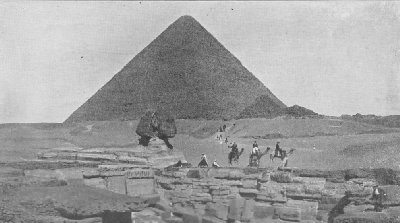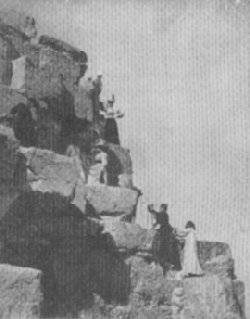|
Not least among the wonders of the world are the Pyramids of Egypt. These stupendous monuments of an ancient dynasty stand on the right bank of the Nile over against Old Cairo. The eye follows with amazement the graded lines of the prodigious masses, showing in the light the profile of their rugged slopes, disposed in flights of fractured steps. They resemble mountains hewn into square blocks rather than structures raised by mortal hands, revealing at it were "the transition between the colossi of art and the giant works of nature." "All things fear time,"—says the Arab proverb,—"but time fears the Pyramids."
The Pyramid of Cheops, or Khufu, the largest of the three, is estimated to cover an area of over 12 acres, while its four triangular sides present altogether a surface of no less than 20 acres in extent. A quantity of material measuring 90,000,000 cubic feet was brought from great distances by way of the Nile, placed on the rocky foundations, raised to a height of over 500 feet, and adjusted with the greatest care. The Pyramid of Cheops, diminished by about 40 feet through the loss of its stone facing and the subsidence of its foundations, has a present height of 456 feet; that of Khephren, or Kephra, about 450 feet; while that of Mycerinus, or Menkera, has less than one-half of these elevations. There are several others on the plateau, of smaller dimensions. Those above named are known as the Pyramids of Gizeh, which is a village in the vicinity. They were constructed during the Memphite Dynasty, which began, according to different authorities, 4235, 3733 or 3666 years before Christ.
SCENES OF GREAT FINANCIAL PANICS |

